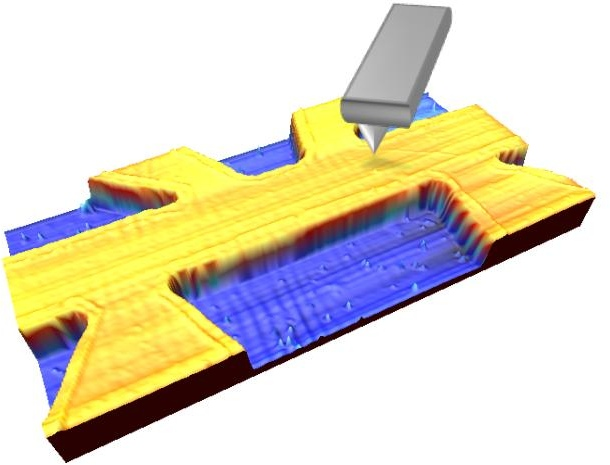Nanoscale Patterning of Superconductivity
Building structures in a sheet of superconducting material could lead to new devices for processing information. Researchers now report in Physical Review Letters that the superconductivity of an ultrathin layer can be dramatically suppressed by electrically polarizing an atomically matched layer on top of it. The team was also able to suppress superconductivity in an array of nanometer-sized dots without affecting the material between the dots, raising hopes for new ways to pattern superconducting circuits.
The zero-resistance state of a superconductor appears below a critical temperature Tc. Researchers would like to manipulate this transition temperature selectively in circuits, or even suppress superconductivity entirely in some places, to make new kinds of devices. They can weaken the superconductivity and lower Tc by reducing the number of charge carriers (either electrons or positively-charged holes, depending on the material). One way to lower the carrier concentration is to expose a thin layer of the material to an electric field that repels the carriers, pushing them into the external circuit. But with traditional electrodes, this “field effect” is often too small to change Tc very much.
To produce higher fields, researchers have turned to the large, built-in electric fields that occur in ferroelectric materials. A team led by Javier Villegas of the CNRS/Thales Physics Lab (UMPhy) in Palaiseau, France, and the University of Paris Sud 11 in Orsay, decided to try the ferroelectric material bismuth ferrite (BFO). It has an especially large polarization (charge separation), which leads to a large field. They grew BFO on top of a very thin layer of the high-temperature superconductor yttrium barium copper oxide (YBCO) in such a way that the BFO atoms were aligned with the atoms of the superconductor underneath.
To measure the BFO’s effect on the superconductor, the researchers applied a voltage to the needle-like tip of an atomic-force microscope (AFM) while scanning it across a region of the BFO surface. The polarization of a ferroelectric aligns with the applied field, much like a permanent magnet, and stays that way even after the applied field is gone. Reversing the BFO polarization over a large area from attracting carriers to repelling them reduced Tc by about 30kelvin—much more than was achieved in earlier experiments by others.
Moreover, by moving the AFM tip to selected locations, instead of scanning over the entire surface, the researchers could vary the strength of superconductivity from place to place. “We are able to reduce the size of the [affected region] to a very small area, to produce these field effects at the nanoscale,” says Villegas. As a demonstration, the team started with a layer that was uniformly polarized to give a high transition temperature. They then used the AFM to reverse the polarization at an array of spots, weakening the underlying superconductivity at those locations.
To see the effect of this array on current flow, the team turned to magnetic fields. An external magnetic field penetrates superconductors like YBCO as an array of discrete lines known as vortices, each carrying a fixed amount of magnetic flux. The number of vortices depends on the field strength. The motion of these vortices shows up as electrical resistance in the superconductor, but the vortices tend to be “pinned” in place at locations where superconductivity is weak. The pinning reduces the vortex-associated resistance.
As they had hoped, the team observed an especially low resistance at magnetic fields where the number of vortices just matched the array of spots they had created. At this field, “there is kind of a collective pinning of all the vortices,” Villegas says, although the exact strength of the pinning is not yet clear. The team is planning to extend the work to create other patterns, such as a so-called Josephson junction—a device made with two superconducting regions separated by a small nonsuperconducting region. More complicated structures that guide the motion of vortices and use them to carry or process information may also be possible.
Jean-Marc Triscone of the University of Geneva suggested crafting circuits using ferroelectrics more than a decade ago. “We are not yet completely there,” he says of the new work, but “if you can, with nanometer precision, write superconductive lines, maybe junctions, maybe arrays of junctions, that would be very, very interesting. Things are moving very quickly.”
–Don Monroe
Don Monroe is a freelance science writer in Murray Hill, New Jersey.







